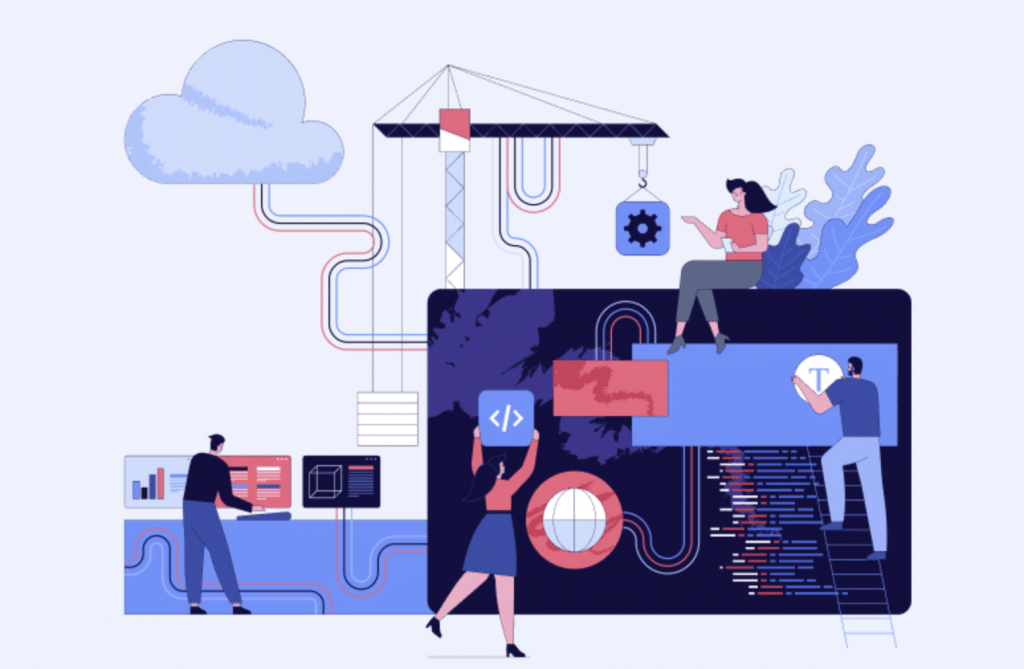Web development has changed significantly over the last three decades and continues moving at lightning speed.
Technologies that were once considered cutting-edge are now commonplace, and new inventions continue to emerge and transform the way we interact with and consume web content.
For a couple of minutes, let’s delve into the future and glimpse the top web development trends that promise to dominate the digital space in 2024.
Jamstack Architecture
Jamstack architecture, composed of JavaScript, APIs, and Markup, is dramatically transforming the way websites are built and deployed.
By disengaging the frontend from the backend, Jamstack helps developers build highly dynamic and performant websites. The separation of concerns leads to faster load times, improved security, and better scalability.
As businesses increasingly prioritize speed and reliability, Jamstack is emerging as a go-to architecture for modern web development.
Serverless Computing
Serverless computing continues to evolve as a significant trend, enabling developers to concentrate on writing code without handling server infrastructure.
With serverless platforms, developers can deploy functions that automatically scale based on demand, optimizing resource allocation and reducing operational overhead.
This trend is expected to simplify development workflows, accelerate time-to-market, and lower infrastructure costs.
Progressive Web Apps (PWAs)
Progressive web application development is erasing the borders between web and mobile applications.
They use modern web capabilities to deliver app-like experiences, such as offline functionality, push notifications, and smooth performance.
In 2024, PWAs are expected to become even more favorable, and businesses are going to leverage them as a strategic tool for enhancing user engagement and expanding their digital presence.
Single Page Applications (SPAs)
Single page applications have become the backbone of modern web development.
SPAs load a single HTML page and actively refresh content as users engage with the app. This approach leads to a smoother user experience, as only the necessary data is brought from the server.
As user expectations for interactivity and speed rise, SPAs are expected to maintain their popularity in 2024, particularly in the development of complex and interactive web applications.
WebAssembly (Wasm)
WebAssembly (Wasm) gained traction as a powerful technology, allowing the execution of high-performance code written in languages such as C, C++, and Rust directly within the browser.
Wasm allows developers to achieve near-native performance, opening up possibilities for computationally intensive tasks, gaming, and other resource-demanding applications on the web.
GraphQL
GraphQL, a query language for APIs, will continue to be widely adopted next year.
It provides a flexible and powerful alternative to traditional REST APIs, allowing clients to request only the data they need. GraphQL simplifies collaboration between frontend and backend teams and improves data fetching efficiency.
As the demand for more streamlined and intuitive data management gains momentum, GraphQL promises to become a staple in web development throughout 2024.
Containerization and Microservices
The adoption of containerization and microservices architecture is crucial for developing applications that are scalable and easy to maintain. Containers, like those overseen by Docker, offer a streamlined and uniform environment for applications.
The microservices approach empowers developers to build scalable and maintainable applications through the use of small, autonomous services that can be deployed and updated independently.
In 2024, organizations will persist in embracing these trends because they enable agile responses to evolving demands, helping maintain a competitive edge.
Web Components
Web Components, a suite of web platform APIs that enable the creation and use of custom, reusable elements, maintain their relevance in 2024. Web Components promote modularity and reusability, enabling developers to build encapsulated and interoperable components that can be easily integrated into different projects.
Headless CMS
Headless CMS (Content Management System) remains a significant trend in the coming year, surpassing traditional CMS solutions that tightly couple the content management backend with the frontend presentation layer.
Headless CMS, however, takes a decoupled approach, separating content creation and storage from content presentation. This separation provides developers with the ability to deliver content across various platforms and devices.
Motion UI and Interactivity
Motion UI and Interactivity continue to play a crucial role in enhancing user engagement. With advancements in CSS and JavaScript libraries, web developers can build captivating and engaging user interfaces.
Smooth animations, transitions, and interactive elements contribute to a more engaging and user-friendly web experience.
What Else to Expect in 2024?
As we look beyond the established trends, several exciting developments are on the horizon for web development in 2024. Among them are:
- Augmented Reality (AR) Integration: Next year, we can expect web development to increasingly adopt AR, enhancing user experiences with highly interactive and immersive content.
- Ethical and Sustainable Web Development: The industry is witnessing a shift towards ethical and sustainable practices. Developers will prioritize creating environmentally conscious websites that leave a less harmful impact on our planet.
- Low-Code and No-Code Development: The adoption of low-code and no-code tools will democratize the development process and allow individuals of different technical backgrounds to contribute to web development.
- Enhanced Web Accessibility: With a growing focus on inclusivity, web developers will prioritize creating accessible websites, ensuring that digital experiences are available to users of all abilities.
Embrace Upcoming Trends to Get a Competitive Edge
The web development trends of 2024 promise an era of outstanding innovation and efficiency.
From the architecture revolution of Jamstack to the streamlined development offered by serverless computing, developers have an array of tools at their disposal to create faster, more secure, and more engaging web experiences.
Still, it’s important for everyone (no matter if you’re a regular user, an independent developer, or a web development company) to stay flexible and open to new technologies during this digital evolution.
By embracing these trends and keeping up with user needs, we can shape a digital landscape that not only meets but surpasses expectations.

